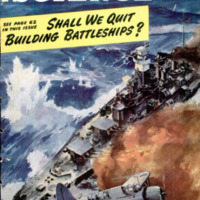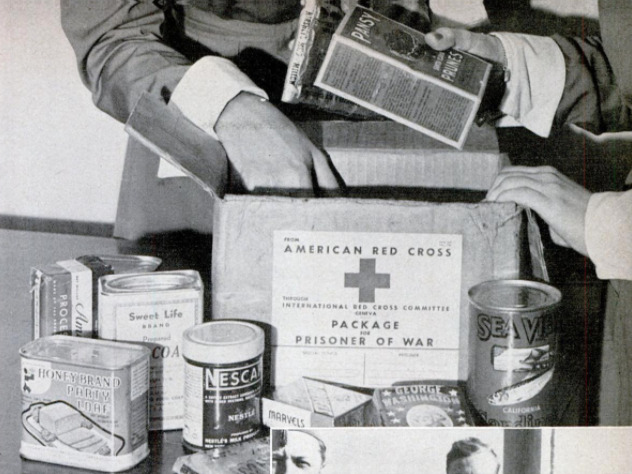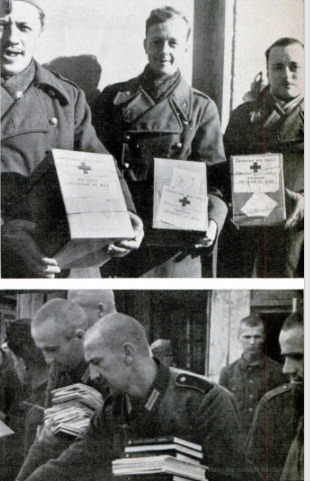-
Title (Dublin Core)
-
Aid for war prisoners
-
Article Title and/or Image Caption (Dublin Core)
-
Title: Men behind barbed wire
-
Subtitle: What is being done for the 6.000.000 fighters who are prisoners of war? This article gives the answer
-
extracted text (Extract Text)
-
BEHIND strands of barbed wire that ring
a thousand camps and compounds on five
continents are the greatest number of war
prisoners this earth has ever seen. Six mil-
lion fighting men are there-—counted out
for the duration of World War II—and it's
anybody's guess how many will follow them
into captivity. Stripped of freedom and
privacy, theirs could be a lost world. But
amazing efforts are being made to prevent
captivity from wholly wrecking their lives.
Not long ago, the problem of war prison-
ers seemed remote to us. But today, with
our heroes of Wake Island, Guam, and Ba-
taan interned, we are aware of the perils of
barbed wire. Headlines that told of Nazi
legions seizing half a million captives in the
first month of the war have new signifi-
cance. We recall announcements of British
losses at Dunkirk, the capitulation of Dutch
and Belgian armies, the staggering Russian,
German, and Italian losses. We remember
that flash reporting the surrender of 2,000,-
000 French soldiers. All of these men have
been behind barbed wire for a long time
now. They are under the watchful eye of
their captors in 40 countries
Americans can be proud of the work their
organizations are doing to aid these side-
tracked warriors of yesterday's battle lines.
Through their international (and that is to
say neutral) offices, the Red Cross and the
YMCA. are the symbols of hope. They
are the sole custodians of the benefits of
the Geneva Convention of 1929—the agree-
ment in which most of the civilized nations
of the world pledged themselves to improve
the lot of prisoners of war.
This is the first major test for the treaty.
Remarkable is the fact that, with the war
breaking virtually every other rule and
pledge, the majority of the signatories have
honored it. The Convention is a belated
product of the first World War, when war-
prison conditions hit a point f below the
recognized measure of refinement. But its
authors hardly could have foreseen the
problem in human welfare to be created 13
years later—the problem which the Y.M.C.A.
and the Red Cross are striving so hard to
solve.
Under the Convention, the Red Cross has
five responsibilities. It is keeping a register
at Geneva of all prisoners of war in all
lands; it is forwarding and exchanging pris-
oners’ mail; it is inspecting war prisoners’
camps to check health and general living
conditions; it is seeing that the convention
is carried out, and, perhaps most important,
it is distributing food, clothing, and medi-
cines among the prisoners.
The Y.M.C.A. has the responsibility of
preventing the dreary days and months of
prison life from wrecking the lives of the
prisoners. Through its program an astound-
ing thing has happened. Practically all of
the prison camps in Europe and Pritain
have their own universities. As many as
28 courses are taught in one prison camp,
with subjects ranging from chemistry, med-
icine, and law to psychology, drama, and
literature. The textbooks are supplied by
the Y.M.C.A. representatives, who also pro-
vide equipment for craft shops, \rades
schools, and a multitude of other things,
including sports and indoor games.
Most of the captor nations have per-
mitted the organization of prisoners’ com-
mittees, and it is through the leaders of
these that neutral Y.M.C.A. representa-
tives and the Red Cross deal. With the
permission of the military authorities of
the detaining power, they are making regu-
lar visits to the camps and talking freely
with the camp leaders. Of constant con-
cern is the question whether the prisoners
are enjoying the fundamental rights estab-
lished for them in the Geneva Convention.
These rights never existed before. Fore-
most is that capture of prisoners be made
known to their own government immedi-
ately, together with official addresses to
which their families may send mall; they
are entitled to humane treatment and pro-
tection from violence and reprisals; they
are to be fed and clothed by the detaining
power; they are to be evacuated at once
from zones of hostilities and, if wounded,
given medical care and repatriation; offi-
cers among the prisoners are to be paid
by the detaining power at the rate of pay
of officers of the detaining power; en-
listed men are to be paid for any work
they do for their captors.
The majority of American prisoners of
war are in the hands of the Japanese, whose
government, though signing the Geneva
Convention, never has ratified it. According
to a report from the British War Office,
5,000 Americans have been interned by
the Japs, half of them in Formosa and
the other half in Korea. There naturally
has been anxious speculation as to the
treatment of our men held by the Japa-
nese, despite Japan's announcement son
after the start of the war that she would
abide by the provisions of the treaty. Red
Cross delegates permitted to inspect some
of the camps and to speak to the prisoners
have reported that conditions, on the whole,
are satisfactory. They have received no
serious complaints.
There are two main causes for worry
with respect to our prisoners in Japanese
camps. One of them is that months after
their internment, Japan has failed to fur-
nish a complete list of the prisoners. These
men are posted as “missing in action” at
Washington, and their welfare is causing
increasing anxiety. But in December Ja-
pan announced that a list of the prisoners
was being prepared for delivery to the
Red Cross at Geneva, and blamed the diffi-
culty of moving the prisoners for the delay.
The other worry is over the food and cloth-
ing situation among the prisoners. They
are being fed the ration of Japanese depot
troops—largely fish and rice. It is feared
that unless that diet is supplemented, the
Americans may suffer from scurvy, beriberi,
or other maladies. The Red Cross has suc-
ceeded in getting one shipment of supplies
to Japan on a diplomatic exchange ship,
and is ready to send great quantities of
specially prepared food parcels as soon as
transportation can be arranged.
Outstanding among Red Cross accom-
plishments has been the preparation and
distribution of these food parcels. They are
the product of the nutrition staff of the
American Red Cross in collaboration with
United States Government agencies and
the Army. They are appropriately called
by those who know their contents “Eleven
pounds of health.” Contents of the parcel
vary from time to time, but the normal
content is: milk powder, 1 Ib.; cheese, 8 oz.;
liver paste, 6 oz.; corned beef, 12 oz.; pot-
ted pork, 12 oz.; raisins, 1 lb.; sugar, 8
oz.; lemon powder, 12 oz.; cocoa, 8 0z.;
coffee, 8 oz.; chocolate, 4 oz.; candy, 6 0z.;
cigarettes, 40; tobacco, 2 1/4 o0z.; lunch bis- |
cuit, 7 oz.; matches, 2 boxes.
If the men in the prison camps can re-
ceive one parcel a week, which is the aim
of the Red Cross, there would be no nutri- |
tional deficiencies. The food in the pack-
ages has been scientifically prepared to
withstand temperatures up to 120 degrees
without decomposing.
Reciprocity is the clew to success in
meeting the problems in the treatment of
prisoners in Europe and Britain. For the
most part, the nations have adhered closely |
to the Geneva Convention in the treatment |
of each other's prisoners. Nazi treatment
of Russians, Poles, and Serbs is another
story. There have been reports of many |
serious abuses in their treatment.
Russia's situation with respect to
war prisoners is unique among the
belligerents. The Soviet Union was
not a party to the Geneva treaty,
and neutral inspectors have been
barred from Red prison camps.
Charges and countercharges have
been tossed back and forth between
Moscow and Berlin from the time
the first prisoners were taken. The
Soviet has accused the Nazis of
starving Red prisoners and subject-
ing them to systematic atrocities
and outrages. The Germans have
countered with claims that the Rus-
sians massacred their prisoners. But,
if reports of newspaper correspond-
ents may be used to judge the situ-
ation, Russian prison camps differ
little from those of other nations.
-
Contributor (Dublin Core)
-
Jack O'Brine (Article Writer)
-
Language (Dublin Core)
-
eng
-
Date Issued (Dublin Core)
-
1943-04
-
pages (Bibliographic Ontology)
-
49-53
-
Rights (Dublin Core)
-
Public Domain (Google Digitized)
-
Archived by (Dublin Core)
-
Matteo Ridolfi
-
Marco Bortolami (editor)
 Popular Science Monthly, v. 142, n.4, 1943
Popular Science Monthly, v. 142, n.4, 1943




